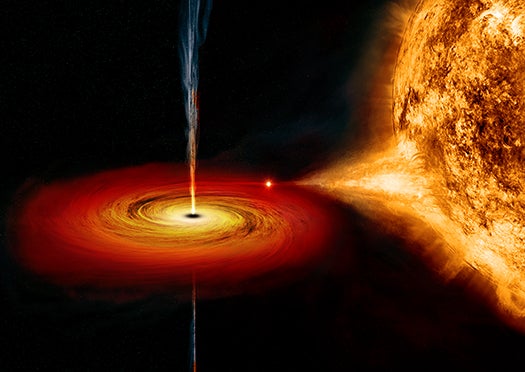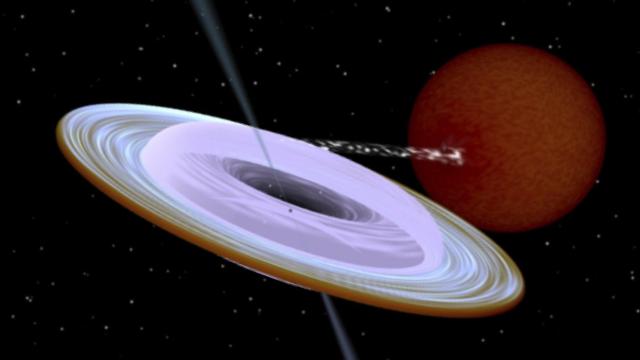A team of astronomers recently observed an askew black hole just 10,000 light-years from Earth. The black hole’s spin axis is out of alignment with the plane of debris orbiting it by at least 40 degrees, the most extreme misalignment of its kind yet seen by astronomers.
The system is called MAXI J1820+70, and it contains a small black hole (about eight times more massive than the Sun) and a star that’s about half the size of the Sun. Astrophysicists recently calculated that the black hole, an incredibly dense object with a gravitational field so intense that not even light can escape, is spinning at an awkward angle compared to stuff orbiting it; the researchers think its tilt may be a relic of how the object was born, in the violent death of a star.
“The main result is that, for the first time, we measure a large (>40 degrees) misalignment between the black hole spin and the orbital spin,” said Juri Poutanen, an astrophysicist at the University of Turku in Finland and the paper’s lead author, in an email to Gizmodo. “In this case, the likely formation channel is a large kick (due to asymmetric neutrino emission) to the black hole during the collapse of the core of a massive star.”
The “kick” Poutanen refers to is the result of the supernova — the collapse of a massive star — that birthed the black hole. The ejection of material from the dying star gave the black hole something called a natal kick, which can knock the massive object out of alignment with neighbouring objects.
“It is not much the ‘hit’ by the explosion itself, but the sudden change in the gravitation field that keeps the two objects together, coupled to the fact that the black hole, during its formation in the supernova explosion, acquires an extreme rotation speed,” said Ferdinando Patat, an astrophysicist at the European Southern Observatory who wrote an accompanying Perspectives article about the new paper, in an email to Gizmodo.

The black hole is slowly pulling material off a neighbouring star thanks to its strong gravitational field, forming an accretion disk around the dense abyss. Some of the star’s material is swallowed by the black hole, but some of it is also ejected in the form of two massive jets of material, spewing out at about 80% the speed of light.
By looking at the angle of those jets and the incline of the orbital plane of the system, the researchers figured out things were off-kilter. “What was missing was the position angle of the orbital plane,” Patat said, “and this was provided by the polarization of light coming from the material on the orbital plane.”
“This is the novelty of the approach,” Patat added. “Polarization carries with it geometrical information that often no other signal carries. It can tell you what is the orientation of an emitting surface, even if you cannot discern the details of the surface.”
More of these misaligned black holes probably exist, Poutanen said, but they’re difficult to measure. The team is planning to look for more, and they’ll also further investigate the structure of this one using data from NASA’s new IXPE satellite, launched in December 2021, to better understand how its tilt became so extreme.
More: See a Black Hole’s Magnetic Fields in New Image From the Event Horizon Telescope
